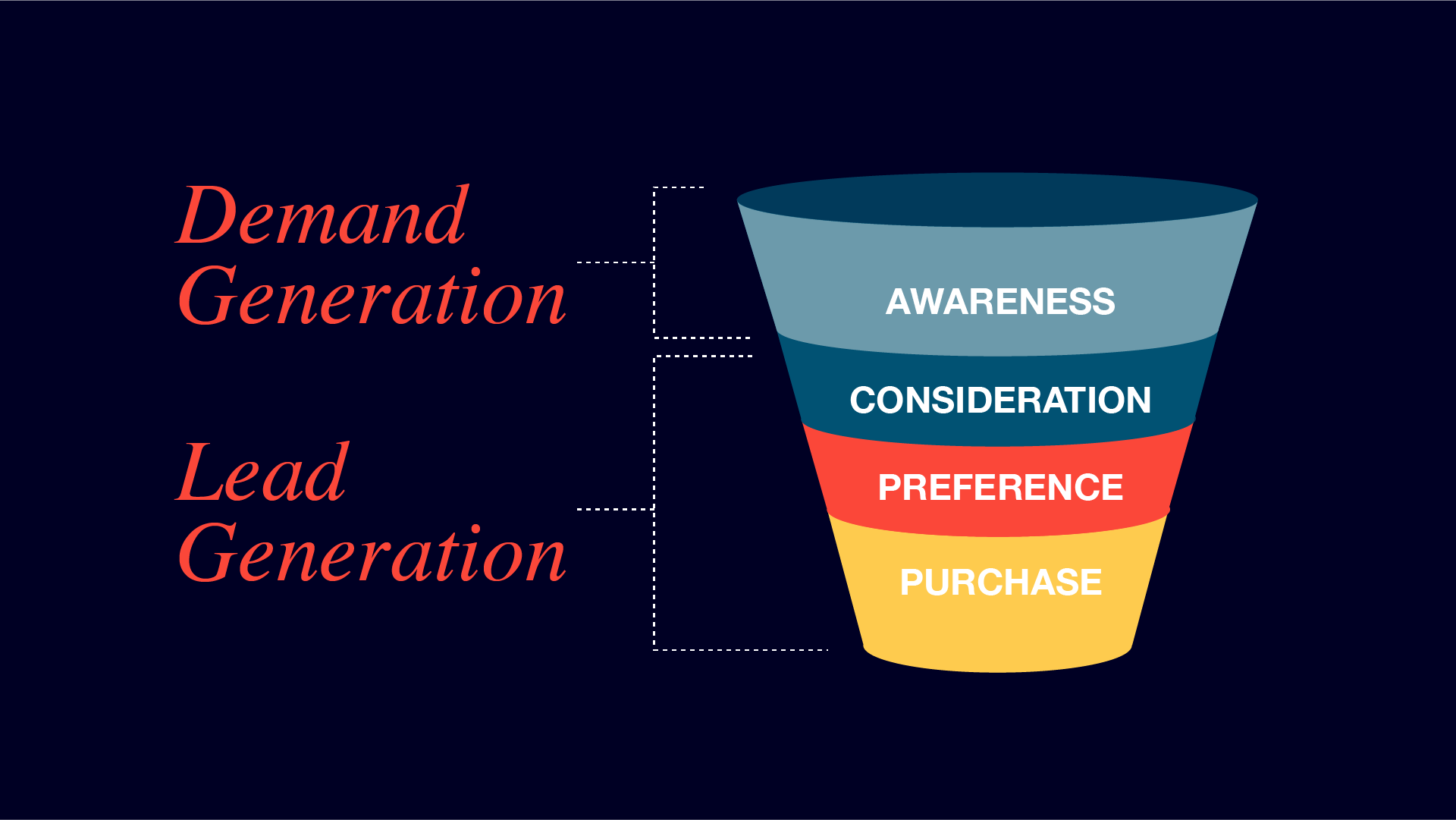
Social Media as Lead Generation: Making Complex Topics Digestible
Breaking complex topics down into simple easy-to-understand concepts is time-consuming and challenging, and it’s easy to feel frustrated and overwhelmed. According to the data, many B2B organizations feel the same way. 50% of B2B organizations struggle to align content efforts across sales and marketing, creating major disconnects and consumer confusion. And with 41% of marketers struggling to generate leads with their content, it’s high time for a fresh approach.
Luckily, we’re here to help you declutter your content and streamline your strategy. Whether you’re having trouble cross-selling or growing the commercial sector, digestible social media content can bridge the gap between your big ideas and your target audience. You just need to know how to streamline your approach.
Difference between demand generation and lead generation
Customers are more in charge of their buyer’s journeys than ever before. And to convince them to purchase your product, they first need to understand why they need it. That means you need to synthesize complex product info into succinct bits of content that drive conversions and create that need-it-now feeling.
But before we dive into tips and tricks, let’s lay the groundwork by differentiating demand generation from lead generation.

Though demand generation and proactive lead generation go hand in hand, they are often conflated and used interchangeably. In reality, they are two distinct processes, and understanding each one individually is crucial to effective marketing.
In simple terms, demand generation is the process of reaching new markets and increasing audience awareness of your products. This generates demand for your services, educating audiences and building trust in your brand.
Lead generation, on the other hand, is the process of transforming that consumer interest into a sale, converting window shoppers to customers by explaining how your product will meet their needs.
Though you need to utilize both to ultimately make a sale, demand generation is a top-of-funnel activity focused on attracting your target audience, and lead generation is a bottom-of-funnel activity that describes the process of conversion.
With successful demand generation marketing, you can cultivate leads that are truly interested in your product.
So, how does social media fit in?
How does social fit in? Generating leads on social media
Social media can be used for both lead generation and demand generation, but the approach and goals may differ depending on the specific strategy and objectives. For example, a business launching a new product and using social media to generate buzz is engaging in demand generation.
But to get audiences to convert and actually buy the product, you need to grease the wheels with lead generation. And in today’s digital landscape, that means utilizing social media marketing to engage potential customers with pitch-perfect content that concerns their pain points.

If audiences don’t understand a product, why would they buy it? That’s where succinct, snappy social media marketing comes in. Social media is an excellent lead generation tool, utilizing online content strategies to capture qualified leads and incorporate them into your sales funnel.
From increasing brand awareness to reaching out to new customers, social media marketing makes it easier to get your target audience’s attention.
After all, social media platforms are designed to make information quick and easy to consume. By breaking down complex topics into bite-sized pieces, businesses can cut through the clutter and present necessary information.
Ultimately, thumb-stopping social content is rooted in approachable copy, especially when it comes to complex topics. And to create clutter-cutting content, you need to identify the key points or phrases that will make audiences stop scrolling and engage. To show consumers why they need your product, you have to understand their pain points.
Common pain points (and tips to solve them)
Understanding the pain points of your target audience provides valuable insight into their needs and challenges. By identifying and addressing these pain points, businesses can establish themselves as experts and thought leaders in their industry and gain the trust of potential customers. Because when you understand your audience’s struggles, you can better explain how your product or service can alleviate those issues, driving conversions.

What pain points should you be on the lookout for?
In our decades of marketing service, these are four of the most common pain points we’ve encountered:
1. Businesses with multiple service offerings/lines geared toward various industry segments.
Often, existing clients only use the company for one service but could be taking advantage of multiple service offerings. Cross-selling is an opportunity they want to capitalize on, but they don’t know where to start.
Solution: Account-based marketing approach
Account Based Marketing (ABM) focuses on a specific group of target accounts within a market, utilizing tailored campaigns to create personalized buying experiences. By personalizing the marketing message to meet the needs of each account, ABM optimizes the use of resources for maximum effectiveness.
By encouraging marketing and sales teams to work together, it’s easier to identify which segments of your customer base would be most receptive to extra products or services. This creates opportunities for cross-selling and upselling. And by playing on these pain points with email campaigns, targeted webinars, and more, you can level up your customer relationships.
2. A parent brand also has sibling brands for various service offerings, and the brands lack alignment.
In the B2B sphere, it’s common for a parent brand to have several smaller sibling brands focused on specific niches within the larger market. And while this may help diversify their product offerings, customer confusion arises when these brands aren’t aligned.
Solution: Storytelling content
When you’re trying to market complicated products or software to consumers, you need to grab their attention immediately with a story that resonates. Whether you highlight a customer testimonial, utilize an infographic, or post eye-catching animations to visualize an abstract product or service, you need to get to the heart of the issue if you want audiences to stay engaged.
These mini content pieces make complex information easier to absorb, helping commercial clients understand how your product or service can better their business, too. And by using different content styles and platforms, you can create a cohesive, digestible whole.
3. A company is growing and, as a result, has created new acquisition opportunities. They need help integrating these acquisitions.
In this scenario, the company needs to communicate directly and effectively. Regular and transparent communication with employees, customers, and other stakeholders is critical to managing expectations and avoiding disruptions. Companies shouldn’t just throw something at the wall to see if it sticks – instead, they need to meet their audiences where they live and where they’re active.
Solution: Direct communication
By concentrating on the platforms where their target audience is most active, B2B companies can better allocate resources, time, and budget for maximum impact. And consistently posting and engaging with customers on a few select platforms helps establish a stronger presence and brand identity.
After all, businesses don’t need to be on every channel all the time. They just need to meet their audience where they are and keep tabs on ever-changing algorithms to stay ahead of the curve and keep people informed.
4. A large percentage of a company’s revenue comes from the B2G sector, but they also service the commercial sector and are having trouble growing there.
B2G clients, or clients that primarily sell their products or services to government entities, often have trouble growing their commercial sector and appealing to commercial customers. So, how do B2G companies successfully penetrate the commercial market?
Solution: Create value through evolved messaging
By using targeted messaging that addresses the specific needs and pain points of the commercial sector, B2G companies can establish themselves as valuable resources for these customers.
To do so, B2G companies must understand their key audience’s micro-moments. Micro-moments are brief instances when a customer is seeking information or assistance, such as when they're researching a product or making a purchase decision. By providing relevant information or solutions at these critical moments, companies can create value for their audience, leading to increased engagement and brand loyalty.
Rev up your social media strategy today!
With the right strategy in place, social media can be a powerful tool for engaging your audience. From healthcare to technology to finance, the experts at Zehnder break down complex ideas into approachable, compelling content. Contact our experts today at beyond@z-comm.com to discover how we can help your business generate leads and succeed!






